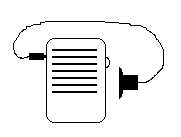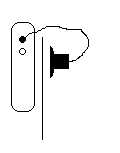
Amplifier amplify yourself
Introduction
An amplifier driven speaker coupled to a magnetic pick-up coil can produce a feedback squeal. This squeal can be blocked by a steel plate. Its frequency can be changed by using aluminum foil.
Material
Assembly
Plug the pick up coil into the input of the amplified speaker.
Basic exploration
To Do and Notice
Turn on the amplifier and turn it to maximum
amplification.
Notice that you can hear the sound of static.
Move the pick-up coil toward the speaker.
Notice the annoying squeal.
Turn down the gain of the amplifier, notice that you must move the
pick-up closer to the amplifier to produce feedback.

What’s Going On?
At high gain you hear "static" as the speaker
amplifies noise. The noise is produced when room temperature makes
electrons move randomly back and forth in the amplifier's input. The
amplifier amplifies these random electrical currents and sends them
to a speaker. In the coils of wire in the speaker the currents
produce changing magnetic fields as well as sound.
The pick-up coil detects the changing magnetic field of the noise and
feeds them back to the amplifier, which is why we call this process
feedback. The amplifier then amplifies them again and sends them to
the speaker once again. Each time around the signal gets louder.
The amplified speaker does not amplify all frequencies by an equal
amount. There is a frequency at which the gain will be maximum. This
is the frequency of the squeal of the feedback. This frequency is
determined by the electronics of the amplifier, and by the
capacitance of the circuit amnd the inductance of the coils.
If you bring a piece of iron near the coil you change its inductance. We'll explore the efects of this change in the next exploration.
Advanced exploration
To Do and Notice
Place the pick-up at a distance that will produce the squeal of feedback. Insert the sheet of steel between the amplifier and the pick-up coil. The feedback will stop.

What’s Going On?
The magnetic fields of the speaker align the ferromagnetic iron atoms in the steel so that the magnetic fields on the other side of the sheet of steel are diminished or canceled. This reduces the feedback and stops the squeal.
To Do and Notice
Remove the steel and create a squeal once
again.
Insert a sheet of aluminum foil between the speaker and the pick-up
coil.
Notice that the pitch of the sound increases.
Fold the aluminum foil over so that it is 4 sheets thick and insert
it again. Notice that the pitch increases even more.
Cut slits in the 4 sheet thick aluminum foil and insert it again.
Notice that the slit aluminum foil does not change the pitch very
much.
Punch holes in 4 sheet thick aluminum foil using a hole punch.
Notice that the holed aluminum foil does increase the pitch of the
squeal.

Aluminum foil squares, one with slices, one with holes
What's Going On?
The changing magnetic fields create eddy currents
in the aluminum foil which create magnetic fields in turn. This
changes the inductance of the pick-up coil and raises the frequency
of the resonant peak.
Thickening the aluminum foil increases the eddy currents.
Slitting the aluminum foil reduces the eddy currents.
Punching holes in the aluminum foil does not impede the eddy
currents.
To Do and Notice
Insert a piece of iron into the space between the speaker and the coil. Listen to the change in pitch. There are two competing effects: iron is a metal and so conducts eddy currents and iron is ferromagnetic. The eddy currents increase the frequency of the feedback while the ferromagnetism decreases the frequency. So iron can either increase or decrease the frequency of the oscillation depending on it conductivity.
So What?
Metal Detectors
The amplifier and coil make a simple metal detector. You can hear when metal comes close to the coil. Real metal detectors also use coil. They transmit magnetic fields into their vicinity and then receive these fields. The fields are modified by the presence of ferrous and nonferrous metals.
Automobile detectors
Many Traffic lights employ coils in the pavement to sense the presence of automobiles. The metal of the automobile changes the resonant frequency of the coil. The change in resonant frequency is sensed and triggers the signal. The iron in the car acts more by its eddy currents than by its ferromagnetic nature so the resonant frequency of the circuit increases in the metal detecting circuot when a car drives over the coils.
|
Scientific Explorations with Paul Doherty |
|
15 Jan 2001 |